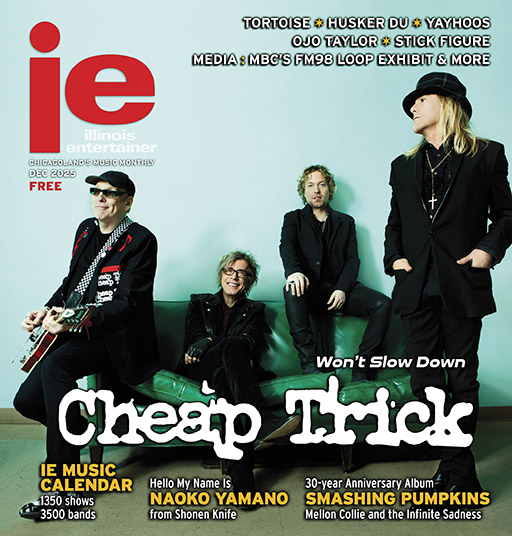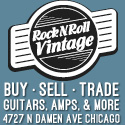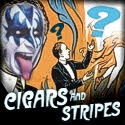Cover Story: The Effigies • The Spirit of the Scene
At its outset, 2023 looked to be an unexpected banner year for Chicago punk-scene legends The Effigies. COVID had finally waned, national concert attendance had rebounded, and the once-moribund music business itself was on a creative upswing — a perfect backdrop for Burned, the band’s latest (fifth) album, a surprise power-chorded treat for longtime fans that it had just finished tracking after regrouping over all that post-2020 pandemic downtime. It looked like a pretty safe bet: The 1980-launched, on-again, off-again Effigies were poised for a pivotal comeback.
But their rose-hued horizon darkened remarkably fast when, on August 26 of that year, founding frontman and professionally competing cyclist John Kezdy lost his life in, of all things, a tragic bike accident on a Chicago route he traveled daily. His surviving bandmates were stunned and initially debated whether to soldier on. “We were in such a good place when that happened because we had just finished all the recording and were rehearsing to start playing live shows again,” somberly sighs Effigies bassist Paul Zamost. “So it was difficult, since at first there was all this survivor’s guilt, like, ‘Why is this happening to ME?’ So I felt bad about that. But Andy (Gerber, guitarist, and Burned producer) wanted to do this reunion more than anybody and returned the question to the band. It’s not like it used to be — bands just continue on these days.”
Indeed. So the friends set aside a period of mourning for grieving, then reconvened with a new vocalist, Geoff Sabin, a graphic designer (who assisted on the recording of The Effigies 2007 Reside LP) who also conceived the timely Burned cover art — a stack of arcane-looking books set stupidly ablaze. Stylistically, Sabin’s singing was 180 degrees different from the late Kezdy’s snarl, but Zamost urged him not to overthink his role. He told him not to think of it as joining a cover outfit but to reclaim catalog classics in his own voice and then forge ahead with all-new Effigies material already being written. Still, that first sans-Kezdy rehearsal was painful for everyone, he adds. “We all kept looking up, expecting him to walk through the door any minute.”
Ironically, Kezdy — who was working full-time as an attorney when he passed — had already displayed a Rasputin-like acumen for survival on July 4, 2022, when he was wounded, along with his wife and 46 others, during Illinois’ infamous Highland Park shooting; she was strafed by shrapnel, he took a bullet directly into his arm, where it lodged stubbornly in the muscle. “He survived that, and it was unbelievable, especially with all the people around him bleeding out and dying (there were seven fatalities),” recalls Zamost. “But he said it didn’t really feel like anything — it just felt like he’d been punched in the arm, although I think he did suffer a bit of trauma from that. And then to die the way he did, hitting an Amazon delivery van? It just didn’t make sense.”
The van had stopped for a delivery on Kezdy’s regular path, but he had his head down, in racing mode, and didn’t see it until it was too late. And the collision was so impactful, he died instantly, with no suable guilty party since the van was double-parked there legally, the driver was just doing his job. It was a tragedy no one could have predicted. Still, The Effigies have surmounted it with relatively apolitical Burned anthems like “Sortie,” “Incident,” “Cede the City,” and “Guns or Ballots,” one of the band’s earliest, technically unrecorded cuts, previously only available on live recordings. A remastered 40th-anniversary edition of its acclaimed For Ever Grounded LP will soon hit the streets. “So I’m not an angry young man anymore,” chuckles Zamost, who just turned 65. “I’m an angry OLD man, and The Effigies have not grown complacent. We never got our due, so we’re still striving, and it’s no longer like, ‘Where are we gonna be in five years?’ It’s like, ‘Where are we gonna be next week?’ We’re getting ready to do five shows with The Black Crowes, and I still can’t wrap my head around that!” He also set aside some time to chat with IE about other issues with Effigies.
IE: What career did you fall into after The Effigies disbanded several times?
PAUL ZAMOST: Well, I hope to retire next March if the band can sustain me again by then. But for the last 15 years, I’ve been in logistics, basically freight, and doing the same thing day after day, and it’s very boring. But on the other hand, I only work two days a week, and the best part of that is, those two days are Saturday and Sunday, I still get full-time benefits, and I work from home, which to me is the greatest thing, ever.
IE: People forget what it was like when you guys started back in 1980. Every major market had its own hardcore punk band, like The Big Boys from Texas, The Zero Boys in my town of Indianapolis, and FEAR out in L.A. You all had your own indie-club tour circuit.
PZ: Yeah! And out in San Francisco, you had Flipper and The Dead Kennedys. We played with The Zero Boys, Black Flag, and The Circle Jerks. We did that until punk was reborn again in the ‘90s, but it was more about scrappy pop tunes by then, all that Blink-182 stuff. But I loved Rancid, because I’m a bass player, and any band that’s bass-driven like that? I always love their music.
IE: Why did you form The Effigies back in 1980? Why then?
PZ: Well, we were all totally into real punk rock. I got into it in 1978, and it changed my whole world. Then I met John and Steve (Economou, original drummer, now back in the group), and it all just clicked. But that world was so different. For instance, we’d have a gig in Detroit, but the minute you pulled out of your driveway and headed to Detroit, that was it — no one can get ahold of you. So then you’d get all the way to Detroit, only to find out that the club got shut down the night before. No one could IM you, no one could send you a text message. We tended to do things much differently back then — a lot of networking but without (gig) confirmations, but I think the whole spirit of the scene was much better.
IE: On many tour dates, you’d have no idea where you stayed each night until the end of your show and fielded crash-on-the-carpet offers from local fans. The Zero Boys crashed at our apartment in San Francisco in those days.
PZ: We did a LOT of sleeping on floors and in friends’ garages — there was rarely an actual bed, although there were a few times when one of us got a Motel 6 room, and five of us piled into it, mainly so we could shower. One of the biggest commodities on the road was actually having a towel! And once in a while, we’d hit a laundry, but most of the time, we’d just trade T-shirts with the other bands and give our T-shirts to them. So a lot of times, when they had photo ops or were doing photo shoots, they’d be wearing our shirts. So there were a lot of band photos with people wearing Effigies shirts in ‘em, and the most famous one is Henry Rollins with H.R. from The Bad Brains — he’s got this Effigies shirt on, and that shot was actually in SPIN Magazine when they did their Top 25 Punk Bands of All-Time. And I remember thinking, “Uhh..so does that make us #26?”
IE: So would The Effigies all get together at Christmas, then? Talk fondly of the next renaissance?
PZ: No. We didn’t really hang out that much. Once we’d get back from tour, we’d see each other at practice, but other than that, we wouldn’t really see each other that much. But then our ’86 tour was such a disaster, so there were a lot of disappointments that led to our breakup. It’s not like we just ended it one night and said, ‘Let’s break up!’ It was more like, ‘Uhh…whoa…let’s rethink things here!’
IE: So what happened on that ’86 tour?
PZ: On the ’86 tour, we had a new album out with Enigma (Records) called Ink, and our second guitar player was very capable, but he just didn’t bring the fire that Earl (‘Oil’ Letiecq) did. So we had a bit of a drop-off there, and punk rock, at that time, really hit a downturn. But it all broke loose again in ’88, although one gig on that tour really stands out. We had a show where Jane’s Addiction was opening up for us, and as soon as they were done, they took the crowd and left! And at the time, I thought that was a real dick move because punk was all about unity, unity with all the other bands. But they just wanted to show the club, ‘This is our crowd; this is who we brought in,’ so they just took everybody and left before we could even play, which was about 2/3 of the house. And I still think that was a dick move, so I was kinda glad to see Perry Farrell self-destruct onstage in September. But after that tour, it got to the point where everyone was pointing fingers, so that’s how it goes. So we all thought it might be best to just move on to other things. So Andy, Steve, and I started a band called Laughing Man, and John went back to our original guitar player, Earl. But we had no idea that we’d still be doing this 45 years later.
IE: And still, with Burned, you’re not planting any political flags, right? Not taking a stand?
PZ: Well, in the (book-burning) cover shot, Geoff’s message comes through. So the politics are on there, but not like, ‘this is a song about blah, blah, blah.’ Or “This other song is about this.’ Even “Cede the City” is pretty much just about leaving a big town, although I didn’t get a chance to quiz John about all of the record’s songs, and usually, I know exactly what he’s talking about. But I think most of these songs are dark and about death. So, the whole enormity of his passing happened to solidify the concept that there is no guarantee of anything in life and no guarantee of getting one more chance at anything. So I’m glad we’ve all settled our old grievances because I think The Effigies are in a very good place. Because sometimes, when you’re away from someone for more than ten years, you don’t even remember what you were mad about in the first place….
– Tom Lanham
Category: Cover Story, Featured, Monthly













